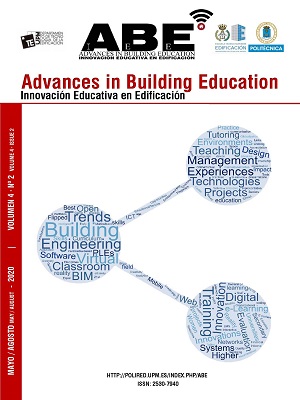Desarrollo de un algoritmo en Python para la simulación y análisis de fiabilidad de los test multirrespuesta = Development of a Python algorithm to simulate and analyze the reliability of multiple choice tests to evaluate the student knowledge
DOI:
https://doi.org/10.20868/abe.2020.2.4461Keywords:
test multirrespuesta, Python, evaluación, algoritmo, multiple-choice test, evaluation, algorithmAbstract
Existe gran número de publicaciones en relación con la fiabilidad de los test multi-respuesta para la evaluación del alumnado en la educación superior. Número de opciones por pregunta, sistemas de puntuación (marcado positivo o negativo), puntuación del conocimiento parcial o cantidad total de preguntas… La combinación de todos estos parámetros es una muestra de la variedad de configuraciones que pueden llegar a establecerse al diseñar un test. ¿Existe algún modelo o configuración óptima? Durante años, los investigadores en innovación educativa han intentado responder a esta cuestión haciendo uso del cálculo de probabilidades y distintas evaluaciones empíricas.
En esta investigación se ha desarrollado un algoritmo basado en código Python con la finalidad de generar una serie de estudiantes hipotéticos con características y habilidades específicas (conocimiento real, nivel de cautela…). Un alto nivel de conocimientos implicaría una alta probabilidad de saber si una de las opciones de respuesta a una cuestión es cierta o no. Un exceso en el nivel de cautela de un alumno estaría relacionado con el nivel de probabilidad que lleva al alumno a arriesgarse a responder a una pregunta de la que no tiene por seguro su respuesta. Ello sería una medida de la capacidad de riesgo del alumno. El algoritmo lanza test a un número específico de alumnos hipotéticos analizando la desviación existente entre el conocimiento real (una característica intrínseca de cada alumno), y el conocimiento estimado por el test.
Una vez desarrollado el algoritmo, se buscó validarlo con el uso de los distintos parámetros de entrada con la finalidad de observar la influencia que estos tenían en la puntuación final del test.
Abstract
There are many literatures related with the reliability of true/false and multiple- choice tests and their application in higher education. Choices per question, positive or negative marking, rewards of partial knowledge or how long they should be… The combination of all these parameters shows the wide set of test setup that each examiner could design. Is there any optimized configuration? An extended educational research has tried to answer these questions using probability calculations and empirical evaluations.
In this investigation, a novel algorithm was designed with Python code to generate hypothetical examinees with specific features (real knowledge, degree of over-cautiousness, fatigue limit…). High knowledge level implies high probability to know whether an answer choice was true or false in a multiple- choice question. Over-cautiousness was related with the probability to answer an unknown question or the risk capacity of the examinee. Finally, fatigue is directly related with the number of questions in the test. Going beyond its upper limit the knowledge level is reduced and the over-cautiousness is increased. The algorithm launched tests to the hypothetical examinees analysing the deviation between the real knowledge (a feature of the examinee), and the estimated knowledge.
This algorithm was used to optimize the different parameters of a test (length of test, choices per question, scoring system…) to reduce the influence of fatigue and over-cautiousness on the final score. An empirical evaluation was performed comparing different test setups to verify and validate the algorithm.
Downloads
References
Ebel, R. L. (1979). Essentials of Educational Measurement. Englewood Cliffs New Jersey, Prentice-Hall.
Lesage, E. & Valcke, M. & Sabbe, E. (2013). Scoring methods for Multiple Choice Assessment in Higher Education – Is it still a Matter of Number Right Scoring or Negative Marking. Studies in Educational Evaluation, vol. 39, pp. 188-193.
Burton, R.F. (2005). Multiple-choice and true/false tests: myths and misapprehensions. Assessment & Evaluation in Higher Education, vol. 30, pp. 65-72.
Burton, R.F. (2004). Multiple-choice and true/false tests: reliability measures and some implications of negative marking. Assessment & Evaluation in Higher Education, vol. 29 pp. 585-595.
Warwick, J., Bush, M. & Jennings, S. (2010). Analysis and Evaluation of Liberal (Free-Choice) Multiple-Choise Tests. Innovation in Teaching and Learning in Information and Computer Sciences, vol. 9 pp. 1-12.
Bush, M. (2001). A Multiple Choice Test that Rewards Partial Knowledge. Journal of Further and Higher Education, vol. 25 pp. 157-163.
Burton, R.F. & Miller, D.J. (1999). Statistical Modelling of multiple-choise and True/False Tests: ways of considering, and of reducing, the uncertainties attributable to guessing. Assessment & Evaluation in Higher Education, vol. 24 pp. 399-411.
Frary, R.B. (1989). Partial-Credit Scoring Methods for Multiple-Choise Tests. Applied Measurement in Education, vol. 2 pp. 79-96.
Downloads
Published
Issue
Section
License
ABE (Advances in Building Education / Innovación Educativa en Edificación) does not charge authors for processing or publishing an article and provides immediate Open Access to its content. All content is available free of charge to the user or his institution. Users are permitted to read, download, copy, distribute, print, search or link to the full text of articles, or use them for any other lawful purpose, without prior permission from the publisher or author. This is in accordance with the BOAI definition of open access.
- Authors retain the copyright and grant to the journal the right to a Creative Commons attribution / Non-Commercial / Non-Derivative 4.0 International (CC BY NC ND) License that allows others to share the work with an acknowledgement of authorship and non-commercial use.
- Authors may separately establish additional agreements for the non-exclusive distribution of the version of the work published in the journal (for example, placing it in an institutional repository or publishing it in a book).
Unless otherwise indicated, all contents of the electronic edition are distributed under a Creative Commons license.














